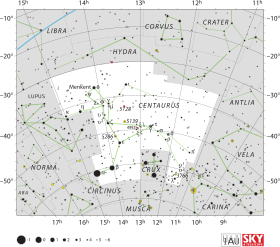Alpha Centauri Bc
Planète extrasolaire
Alpha Centauri Bc (α Cen Bc) est un possible compagnon planétaire de l'étoile Alpha Centauri B. L'existence de cette planète, la deuxième proposée dans ce système après Alpha Centauri Bb (dont l'existence a été contestée en 2015[3],[4]), est suspectée à la suite de l'observation d'un événement semblable à un transit devant cette étoile. Cette planète aurait une période orbitale d'environ 12 jours (environ 3 fois plus longue que celle d'Alpha Centauri Bb)[1],[5].
| Alpha Centauri Bc | |
| Étoile | |
|---|---|
| Nom | Alpha Centauri B |
| Constellation | Centaure |
| Ascension droite | 14h 39m 35,0803s |
| Déclinaison | −60° 50′ 13,761″ |
| Distance | 1.339 ± 0.002 pc = 4.366 ± 0.007 al |
| Type spectral | K1 V |
| Magnitude apparente | +1.33 |
Localisation dans la constellation : Centaure | |
| Caractéristiques orbitales | |
| Demi-grand axe (a) | 0,10 ua [1] |
| Excentricité (e) | < 0,24 [1] |
| Période (P) | 12,4 d ([1] a) |
| Caractéristiques physiques | |
| Rayon (R) | 0,92 ± 0,06 RT [1] |
| Découverte | |
| Découvreurs | Demory et al.[2],[1] |
| Programme | STIS sur Hubble |
| Méthode | Méthode des transits[1] |
| Date | 2013 |
| Statut | Candidat non confirmé |
| modifier |
|
Références
modifier- (en) LePage, Andrew, « Has Another Planet Been Found Orbiting Alpha Centauri B? », Drew ex Machina, (consulté le )
- Demory et al. 2015.
- Devin Powell, « Disparue ! L'exoplanète la plus proche de notre système solaire n'existe plus », sur national geographic, (consulté le )
- (en) V. Rajpaul, S. Aigrain, M. A. Osborne, S. Reece, S. Roberts, « A Gaussian process framework for modelling stellar activity signals in radial velocity data », sur Monthly Notices of the Royal Astronomical Society, (consulté le )
- (en) Aron, Jacob, « Twin Earths may lurk in our nearest star system », New Scientist, Reed Business Information, Ltd., (consulté le )
Bibliographie
modifier- [Demory et al. 2015] Brice-Olivier Demory et al., « Hubble Space Telescope search for the transit of the Earth-mass exoplanet Alpha Centauri Bb » [« Recherche du transit de la planète de masse terrestre Alpha Centauri Bb avec le télescope spatial Hubble »], Monthly Notices of the Royal Astronomical Society, no 450 (2), , p. 2043-2051 (DOI 10.1093/mnras/stv673, arXiv 1503.07528, lire en ligne)Les coauteurs de l'article sont, outre Brice-Olivier Demory, David Ehrenreich, Didier Queloz, Sara Seager, Ronald Gilliland, William J. Chaplin, Charles Proffitt, Michaël Gillon, Maximilian N. Guenther, Bjoern Benneke, Xavier Dumusque, Christophe Lovis, Francesco Pepe, Damien Ségransan, Amaury Triaud et Stéphane Udry.
L'article, reçu par le journal le 16 mars 2015, a été accepté le 25 mars 2015, prépublié sur arXiv le même jour, puis publié en ligne le 30 avril 2015 avant la sortie de l'édition papier le 21 juin 2015.
